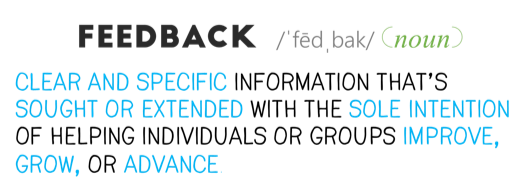In my first two blogs on this topic (blog one and blog two), I made the case that it’s time (actually, well past time) to fix feedback and realize the full positive power feedback can bring to us and our organizations. I offered a new definition of feedback and outlined four things that you may think are feedback, but actually aren’t.


If you’ve been reading along and following my suggestions, you’ve practiced being specific and you’ve let go of your “people fixer” mindset. Now, let’s break the habit of the “manager tell.”
DON’T indulge in only “manager tells.” DO engage in a conversation.
Looking back at our new definition of feedback above, you’ll see that we’ve highlighted the words “sought and extended.” Helpful and effective feedback is as much about soliciting as it is about offering, with the aim of bringing information into a shared conversation. The most powerful action any of us can take is to seek more feedback, inviting those around us into a safe relationship that minimizes fear and allows trust to flourish. So, what do you take away from this view? Simply this: helpful, effective feedback is a two-way process, based on trust.
Traditionally, feedback has been a directive process – a manager “tells” an employee the good, the bad, and the ugly. The employee listens (maybe), asks a question or two (possibly), thanks the manager (sincerely or not), and leaves (maybe happy, but more often, hurt, huffy, and a little more disengaged). In my firm, we refer to this old-school approach as the “yell and tell.” Can we all agree that the old way simply isn’t helpful? So why would anyone want to “seek” that?
To unleash the true power of helpful, positive feedback, both parties must come into the conversation in a relationship of trust, each with open minds. If you’re a manager, build that trust by providing ongoing supportive, specific feedback that clearly bears the intention of helping someone grow and develop. Know that your intent is always showing! Strengthen trust by demonstrating that you understand that it’s not about your agenda; instead, it’s about their future and their career. Check yourself for biases and untested assumptions. Ask questions along the way. Do you truly understand all the influences and perspectives of the person you’re providing feedback to? If you haven’t paused to ask questions and allow safe space for that person to offer their own perspectives, then the answer is no. Honor the questions and input extended by the other party. To reach master class level, make sure you’re also seeking feedback yourself (with sincerity).
If you’ve been steeped in the old ways of doing things, these are not easy changes to make. Building trust and new engagement habits takes commitment, time, and practice, so it’s best to get started right away. Start having open two-way conversations early and often. We’ll tackle one more issue in my next blog. Meanwhile, I hope you are starting to feel your growing power to #FixFeedback.
Business & Finance Articles on Business 2 Community
(45)



